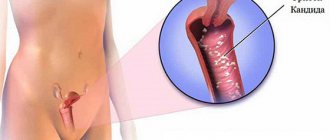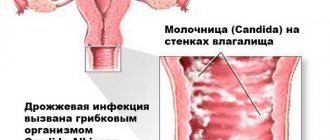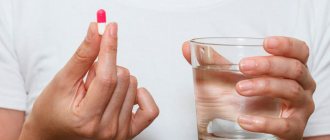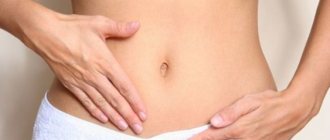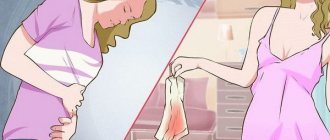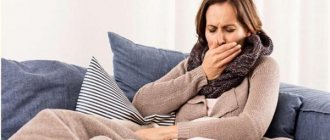Thrush is a fungal disease caused by yeast fungi of the genus Candida. If a fungal infection affects the genital mucosa, its main symptom is terrible itching and severe burning, with symptoms most pronounced in the evening and at night. The itching with thrush is so strong that it disrupts a woman’s sleep and normal rest. Moreover, in particularly sensitive people it can cause neuroses and neurosis-like conditions.
How to eliminate unpleasant sensations
You can eliminate the burning and itching of thrush in several different ways. However, it is worth remembering that none of them brings complete recovery and does not cancel a visit to the doctor to prescribe full treatment.
All local methods of eliminating itching can be considered a kind of “first aid”, but a doctor will help you get rid of thrush completely.
Here's how to relieve severe itching and burning:
- Washing with baking soda solution.
For 1 liter of warm boiled water you should take 1 tbsp. spoon of soda, stir until completely dissolved. Gently wash yourself with the resulting solution and wipe the vaginal walls with a cotton pad soaked in the solution.
- Douching with hydrogen peroxide.
Under no circumstances should you just take a ready-made pharmaceutical solution! Hydrogen peroxide is dissolved in warm boiled water at the rate of 2 teaspoons per 1 liter of water. The resulting solution is used for 10-15 minutes of douching with a slow stream.
- Washing with herbal decoctions.
Decoctions of chamomile, calendula and oak bark soothe itching and reduce inflammation of the mucous membrane. For the best effect, it is advisable to use all three ingredients in one decoction.
- Treatment with antiseptic solutions.
A solution of miramistin or chlorhexidine applied to a cotton pad should be used to treat the vaginal walls and mucous membrane of the external genitalia.
- Antifungal ointment or cream.
Clotrimazole-based cream softens the mucous membrane well and can relieve itching in just a few minutes. It is highly advisable that the cream be prescribed by a doctor who will select the active ingredient in accordance with the severity of thrush and the individual characteristics of the body.
Dilute 2-3 drops of tea tree oil in warm boiled water, moisten a cotton pad or swab with the solution and treat the external genitalia and vaginal walls.
Before taking any drug, be sure to consult your doctor.
All these remedies will help relieve severe itching and alleviate the condition, but it should be remembered that they do not kill the fungal spores remaining in the glandular layer of the vaginal wall, so a relapse of the disease is possible after a while. For full treatment, systemic therapy, diet and proper care will be required.
Factors to consider
There are a number of factors that increase itching and provoke a recurrence of thrush, so they must be eliminated. Here's what you should definitely do to reduce discomfort and prevent it from recurring after treatment:
- Follow a diet: do not eat fatty foods, sweets, yeast baked goods, cheeses (especially blue cheeses), do not drink alcohol and carbonated sweet drinks. All these products create favorable conditions for fungus and provoke itching.
- Wear loose underwear made from natural fabrics. Tight synthetic underwear can cause severe itching and discomfort.
- Wash frequently with warm water without scented soaps and gels. It is better to use antiseptic solutions or herbal decoctions.
- Use only cellulose-based pads, without deodorizing or scented components. It is better to avoid tampons altogether and not use them even after treatment.
- To prevent itching from returning after treatment, the normal microflora of the vagina should be restored. To do this, you can use Lactagel topically, as well as drink natural yogurt with live cultures of lactic acid bacteria every day.
By following these simple recommendations, you can significantly reduce itching and also make it easier to treat thrush. It also happens that unpleasant sensations bother a woman after treatment, when, it would seem, everything is behind.
To prevent itching after treatment, you should follow a diet for another 2-3 weeks after the therapeutic course.
It is also necessary to observe the hygiene standards given above for a long time after treatment. And it’s better to give up synthetic underwear forever.
Sometimes burning and discomfort after treatment indicate vaginosis - vaginal dysbiosis caused by the treatment itself and the use of antiseptics. To avoid such complications after treatment, care should be taken to restore normal vaginal microflora.
Itching with thrush is a common manifestation of candidiasis, an inflammatory disease in women. Itching sensations most often appear along with a burning sensation. These manifestations not only do not subside over time, but also become more intense and may not calm down for a very long time. Moreover, the itching is generally very strong and unbearable. Not only does it interfere with leading a full life, but it even interferes with sleep at night and causes constant discomfort in everyday life. The intensity of itching is cyclical - periods of its intensity can alternate.
If it stings and burns a lot, how can I reduce the pain?
There are 3 treatment options: ointment, douching and tablets. The cost of each option varies from 50 to 500 rubles. Ointment is more expensive.
How to quickly get rid of a burning sensation with ointment?
The following pharmaceutical ointments are distinguished:
- Pimafucin. Contains natamycin, which kills any type of fungus. The component soothes and eliminates the symptom. It is necessary to smear after taking a shower and during the day if the area is very itchy.
- Pimafukort. Consists of: natamycin, neomycin and hydrocartisone. Be careful, neomycin is an antibiotic, and hydrocartisone is a hormonal agent. This ointment should be used as prescribed by a doctor!
- Miconazole. A universal remedy applicable to the treatment of fungi, bacteria and microorganisms. Intended for acute lesions and relapses.
How to relieve itching at home with douching
The best helper is chamomile, consisting of soothing and antibacterial components. Recipe step by step:
- Take dry plants and a liter of hot water. If there are no fresh flowers, buy the collection at the pharmacy.
- Pour boiling water over the plant and cook over low heat until it boils. If the itching is excessive, add a spoonful of calendula.
- When the water boils, turn off the heat and leave the liquid to cool.
- Using cheesecloth or a special container, strain the liquid to remove any plant pieces.
- Buy a vaginal douche at the pharmacy and pour the decoction into it.
- Lie down in the bath and pour the broth into the vaginal opening. Repeat the procedure 2-3 times a day if there is severe itching after washing.
Are there any pills to relieve the burning sensation?
Tablets against candidiasis contain anti-inflammatory and soothing components, which reduces itching. Among the popular drugs:
- Pimafucin - 20 tablets will cost less than 500 rubles. Suitable for the treatment of Candida albicans. Drink straight.
- Fluconazole is an effective, inexpensive drug. Suitable for treating the first stages of the disease - the substance fluconazole blocks the spread of Candida.
- Diflucan – kills all types of fungi, taken once. Combination with other medications is prohibited.
Causes of itching
A woman experiences particular discomfort during urination, sexual intercourse and menstruation, because at these moments the irritation of the mucous membranes intensifies. Also, itching tends to intensify from overheating of the external genitalia, wearing tight underwear with synthetics. Long walking and water treatments can also have a detrimental effect on a woman’s well-being.
Itching with thrush is due to a neuro-allergic nature. Its intensity can be divided into three forms:
- Medium intensity;
- Continuous;
- Intensifying.
The third type is the most difficult to tolerate, because the external genitalia are constantly itchy. All attempts to calm it down are unsuccessful, and scratching only worsens the pain. When urinating, pain appears, which interferes with its normal emptying. In addition to all of the above, itching may occur in the anus area.
You can get rid of painful itching only by eliminating the disease itself.
Helping ourselves
During an exacerbation, a woman is constantly bothered by itching. Sometimes it is so unbearable that when scratching them, she injures the mucous membrane. Cracks and areas of inflammation form, which at the slightest irritation cause pain and burning. During this period, therapy is aimed at destroying Candida fungi.
Only a doctor recommends medications that prevent irritation and relieve the symptoms of thrush. Independent choice of medications is dangerous!
Medication methods
With the help of drugs it is possible to quickly relieve symptoms. Their action is aimed at destroying the fungus. The permeability of the cell membrane increases, which leads to its death. How to relieve itching and pain from thrush:
- Clotrimazole cream. Use immediately at the first symptoms. The effect is calming. Destroys Candida fungus. Apply a thin layer of the drug to a cleanly washed perineum and gently lubricate the inflamed tissue. The drug Miconazole has a similar effect.
- Vaginal tablets Clotrimazole. When inserted into the vagina, it is possible to alleviate thrush and get rid of irritation of the mucous membrane of the vulva, vagina and anus.
- Polygynax candles. They restore the trophism of the mucous membrane, thicken it and have a detrimental effect on Candida fungi. You can get rid of the infection in a short period.
- Terzhinan. Complex drug. Candles contain several “killer” components that have an antiseptic effect.
- Diflucan. For treatment use one capsule. Drive deep into the vagina. In mild cases of thrush it helps a lot.
Folk remedies
There are recipes that traditional medicine has long “tried.” They do not cause harm to health and help relieve itching in both the vagina and anus. First of all, natural ingredients and natural products are used.
- A decoction of chamomile, sage, leaves of St. John's wort, yarrow, and calendula has an antimicrobial effect. One tablespoon of herb is poured into a glass of boiling water and cooled to normal temperature. Used for douching. Do this type of irrigation if the itching intensifies. Washing with infusion eliminates the symptoms of candidiasis, washes away excess discharge and reduces itching in the vagina, anus and perineum.
- Baking soda is effective because it quickly alkalizes the vagina and makes it impossible for Candida fungi to reproduce further. Relieving the itching of thrush and mitigating the course of the infection is much easier and safer than using medications whose effects you are not sure of. Prepare a mixture of a liter of water (boiled!) and a tablespoon of soda. Some recipes add a tablespoon of salt. Stir the contents until completely dissolved and douche. The method is effective, works immediately and reduces pain and itching. Use for irrigation and washing.
- Oak bark works well for thrush. Brew 2 tablespoons in boiled water. The mild astringent property and drying effect will soothe the inflamed tissues of the vulva and help relieve itching in the anus. The prepared infusion is poured into a basin and sat in it for 15 minutes. Afterwards, dry with a towel and apply a medicinal cream prescribed by the doctor.
- The use of borax and glycerin lotions soothe the skin with thrush. Provides relief from itching, swelling and swelling of the perineum.
- Potassium permanganate and its weak solution are used for vaginal irrigation, washing and baths. It has a detrimental effect on Candida fungi and destroys its structure.
Women are interested in how quickly and with what medications they can get rid of itching due to thrush. The danger is that not everyone treats the infection with due attention. It is dangerous to self-medicate not only during pregnancy, but also in other cases when a woman frantically searches for an answer to the question “what to do?”, experiencing severe itching, trusts the advice of friends and messages on the forum.
Contact with a doctor and examination by a gynecologist helps relieve itching due to thrush, solve the problem faster and safer than “dubious” sources would advise.
Thrush, or candidiasis
This disease is caused by Candida fungi. The disease can develop in women of any age, not necessarily women of the reproductive period. Candidiasis may appear after sexual intercourse. Candida fungi, which, under the influence of various factors, began to actively reproduce, could previously be part of a completely healthy microflora.
Thrush is not related to sexually transmitted diseases. It is much more susceptible to treatment and is not as dangerous. The incidence of candidiasis in warm countries is much higher. About 30-40% of women who get thrush experience it during pregnancy. Recently, statistics indicate an increase in the level of this disease. This is directly related to the fact that many women often use antibiotic treatment without the knowledge of the doctor, as well as the weakening of the immune system of patients.
Causes
Why does the itching not go away after thrush treatment? There may be several reasons, and almost all of them are associated with incorrect treatment, which the patient prescribed for himself, hoping for a “Russian maybe.” So, why might “there” be itchy?
- After treatment, the vaginal microflora suffered and has not yet returned to normal. By acting on opportunistic microorganisms that cause candidiasis, we interfere with the functioning of the organ and suppress some of the bacteria necessary for normal functioning. But if we had not done this, we would not have eliminated the disease completely, so we will have to come to terms with this fact. To relieve itching, you need to restore the microflora.
- After thrush, itching appeared, and even more intense. This indicates an allergic reaction to the drug. The medicine did not suit you, and the best way to correct the situation is to stop taking it and go to the doctor to get tested and determine that it is an allergy, and not a new round of infection.
- After the thrush, the itching on the outside remained, but the discharge went away. In this case, perhaps the body has not completely healed. Candidiasis could be advanced or caused by internal causes that
have not yet been corrected. This means that it is necessary to get tested to make sure that the disease has completely subsided. Most likely, it has not yet passed or has been reactivated due to more serious internal pathologies. - The itching after thrush does not go away even if the patient self-medicated. The lack of complex therapy and unauthorized termination of the course cannot guarantee complete healing, unlike treatment under the supervision of a doctor. You have probably suppressed some symptoms, but candidiasis still asserts its rights.
Causes of thrush
In order to select an adequate treatment that will not only help relieve itching due to thrush, but also eliminate the main cause of the disease, it is necessary to consider the factors that are the root cause of candidiasis. These include:
- Stress, psycho-emotional stress, chronic lack of sleep, overwork;
- Vaginal dryness during sex contributes to the formation of microtraumas;
- Impaired metabolism (diabetes mellitus), in which the level of carbohydrates increases, they, in turn, feed microorganisms;
- Smoking (due to vascular spasms, the blood supply to organs, including the genitals, is disrupted);
- Excessively high body weight (fat folds on the body are excellent conditions for the proliferation of fungi);
- Chronic lack of vitamins, as a result of which immunity decreases and mucous membranes suffer;
- Synthetic underwear (thongs are especially harmful);
- Hygienic products with fragrance (can cause allergies);
The above reasons reduce the number of lactobacilli, which create a protective environment and contribute to the formation of an alkaline environment in the vagina. Then fungi and bacteria gain free access to the genitals, where they begin to actively divide, destroying healthy cells. Thus, if this disease is not treated, it becomes widespread and soon unbearable itching appears.
How to get rid of the symptoms of candidiasis?
Most women who notice the first manifestations of thrush do not pay much attention to them and postpone a visit to the gynecologist until later. However, this is completely wrong, since an untreated disease can lead to serious pathology.
At the first examination, the gynecologist conducts an external examination, then, if necessary, diagnoses and prescribes treatment for thrush. As a rule, a specialist will prescribe certain medications and give recommendations on how to get rid of severe itching at home.
Often, itching begins when you least expect it, usually at night. What to do? How to relieve itching due to thrush and sleep peacefully?
There are plenty of methods that perfectly relieve skin irritations and remove minor damage to the mucous membrane. Herbs can help relieve itching.
First of all, you should not panic and immediately go to the pharmacy for expensive medications. Sudden movements only increase the itching. Almost all women have Miramistin in their medicine cabinet. Miramistin is an antiseptic with an antimicrobial effect. You need to lubricate the vaginal walls with it, and you will immediately feel better. Chlorhexidine (this is also an antiseptic) will also help relieve itching.
Ordinary iodine will help relieve itching due to thrush. It is enough to dilute just one spoon of iodine in 1 liter of hot water and let it brew for about twenty minutes. Then pour the resulting solution into a wide bowl and sit until the water cools down. To prevent the water from cooling quickly, cover yourself with a blanket. To prevent itching and burning from happening again, do this procedure every day for a week.
Glycerin and borax will not help cure candidiasis, but this is what you need to quickly relieve the itching. First you need to take a bath, then thoroughly clean the vaginal walls from unpleasant discharge and then treat well with this solution. To do this, you will need: wrap your finger in a sterile bandage, dip it in the solution and thoroughly clean the vaginal walls.
Symptoms of thrush
Symptoms include:
- Itching and burning. When glycogen breaks down, acids appear. It is they who cause such unpleasant manifestations and irritate the vagina, causing severe discomfort. Therefore, you need to ensure that your skin remains dry after urinating and washing.
- Plaque and discharge. It happens that thrush goes away without discharge, but with itching. And the white coating is due to the proliferation of fungi.
- Swelling of the internal and external genital organs. The vessels of the mucous membrane increase - this is the body getting rid of poisons released by fungi.
- Painful sensations during sex. As a result of reproduction, the integrity of the mucous membrane and epithelial cells is disrupted, affecting their deeper and deeper layers. Micro-ulcers appear, which lead to pain during sex.
- Thrush rash. The result of the pathogenic effects of fungi are small pimples filled with fluid. They eventually burst, forming sores that look like a rash on the genitals.
- Localization to nearby skin areas.
- General malaise.
- Cystitis and urethritis. Increased urination indicates that fungi have begun to parasitize the urinary system, causing concomitant diseases. Aching pain in the lower abdomen is a common sign of such manifestations. There may even be an increase in body temperature.
Symptoms characteristic of thrush
Most often, itching and burning in the vaginal area are manifestations of thrush, which in gynecological practice is called candidiasis. This disease, in addition to the indicated symptoms, is accompanied by cheesy discharge from the genital tract and a specific sour odor. In addition, over time, the infection spreads to the urethra, as well as the external genitalia, causing discomfort in the form of stinging and pain when urinating.
Itching during thrush is accompanied by a number of general signs of inflammation, namely:
- local redness of the mucous membranes;
- local soreness;
- tissue edema and local hyperemia;
- burning in the perineum and external genitalia.
Vaginal candidiasis
Depending on the intensity and severity of the manifestations of the disease, experts distinguish three main types:
- moderate;
- increasing;
- unabated.
The third form of the disease, namely persistent thrush, is most difficult for patients to tolerate. With this disease, a woman experiences constant itching in the perineum, anus and vagina, and any attempts to relieve tension do not bring relief. Scratching only increases discomfort and turns it into sharp pain. Over time, problems appear with emptying the bladder in the form of pain when urinating.
Diagnostics
If thrush is detected, you must definitely visit a gynecologist. It is necessary to diagnose the disease and begin proper treatment immediately, because the symptoms of candidiasis are in many ways similar to the symptoms of other, much more dangerous infections that are spread through sexual contact. It is also necessary to visit a doctor if thrush recurs; it tends to become chronic.
To diagnose thrush, a smear is taken from the vagina (bacterioscopy), which will determine the microflora and the presence of fungi.
Sometimes, in order to establish the type of candida that caused the disease, microflora culture is indicated. This is especially important if the patient has been treated for the disease more than once.
An effective way to diagnose is to examine the vagina with a colposcope.
If candidiasis is caused by chronic diseases, you may need to consult an endocrinologist, therapist, or immunologist.
Types of itching
By the nature of the itching you can understand what exactly is happening to you, and this is still fortune telling on the station square. Accurate diagnosis is carried out only with the help of laboratory tests. Before relieving itching and irritation, consult your doctor for advice.
| nature of itching | probable reasons |
| moderate itching, worse at night and with urination | 1) “fatigue” and slow recovery of microflora after treatment; 2) reaction to medications - almost everyone has such an adverse reaction indicated in the instructions. |
| increasing itching that intensifies periodically | 1) allergic reaction to the medicine; 2) the disease has not gone away completely or returns again after treatment. |
| severe itching, which is sometimes accompanied by burning and irritation and prevents you from sleeping at night. | 1) severe allergy to the drug; 2) the thrush did not go away, but intensified or returned immediately, and the reason for this is improper treatment or internal problems; 3) self-medication, which greatly damaged the microflora. |
Ways to relieve itching due to thrush
How to relieve itching from thrush and reduce inflammation? The most effective and fastest way to eliminate itching and other manifestations of candidiasis is drug treatment.
Drug therapy
Antifungal drugs must be prescribed by a doctor. They perfectly relieve itching and burning. The following treatment may be suggested:
- Clotrimazole cream can be used immediately after the first symptoms appear. It has a calming effect and effectively kills Candida fungi. Before use, you need to wash thoroughly, and rub the cream onto the dried genitals with gentle movements and leave to absorb.
- Clotrimazole tablets are inserted into the vagina, which provides relief from the disease, reduces irritation and helps get rid of itching due to thrush.
- Polygynax suppositories have a restorative and strengthening effect on the mucous membrane and kill pathogenic fungi. They allow you to forget about the disease in the shortest possible time.
- The Terzhinan complex in suppositories has several active components that have an effect and have antiseptic properties.
- Diflucan capsules are perhaps the most advanced remedy. To relieve itching from thrush and get rid of fungi, you need to use just one capsule. It is inserted as deep as possible into the vagina and is extremely effective in the treatment of mild candidiasis.
Thrush can be treated with tablets. This method is particularly effective and allows you to forget about itching and thrush in 1-3 days, while using vaginal medications will take about a week.
Another indisputable advantage in favor of the tablets is the fact that such treatment kills thrush fungi in all organs and tissues of the body. This significantly reduces the risk of relapse of the disease. If the disease is relatively mild, it is enough to take just one antifungal drug.
Methods for getting rid of itching due to candidiasis
Thrush that occurs without itching or burning is a very rare occurrence. Usually a sick woman is haunted by only one thought: how to get rid of the itching. There are many means to reduce discomfort, but the first rule of treatment is that you need to get rid of not the symptoms, but the very cause of the disease.
As long as the fungus is in the body, the discomfort that accompanies it will return. Therefore, the disappearance of itching after the measures taken is not a reason to calm down and stop treatment, otherwise you will have to get rid of it again and again.
Ideally, the process of getting rid of thrush should occur under the guidance of a doctor. Only a professional physician, after a series of tests, will be able to accurately determine whether the prescribed therapy really helped or whether the disease simply “hidden” for a while.
Doctors usually prescribe complex treatment, which includes:
- a course of antibiotics and antifungals taken orally;
- local medications - ointments, creams;
- cycle of hygiene measures - douching, washing;
- measures to treat the sexual partner.
Strong antibiotics are prescribed only by a doctor; independent uncontrolled use of such drugs is unacceptable. But there are situations when it is not possible to get to the clinic right away. Then you can try to reduce the itching at home, so that you can calmly treat the candidiasis itself. So, let's look at all the available methods in more detail.
Hygiene rules for itching
It is necessary to follow simple rules for prevention:
- Mandatory washing with cool water without using soap after visiting the toilet;
- You should not use hygiene products in tampons during your menstrual period;
- Wearing regular cotton underwear (thongs, tangos and synthetics are contraindicated);
- Alcoholic drinks and smoking are prohibited;
- Refusal of sexual relations with a partner during treatment.
Relieving itching during pregnancy
In order to get rid of itching and burning during pregnancy, as well as to completely eliminate the disease itself, it is very important not to self-medicate, but to act in strict accordance with the recommendations of the attending physician. The most dangerous treatment will be in the first trimester of pregnancy, when all organs and systems of the fetus are actively developing.
In order to alleviate the condition and get rid of painful itching, topical ointments and suppositories are used. Douching is strictly contraindicated. Tablets only as prescribed by a doctor and under no circumstances in the first trimester. If, while carrying a child, at least one manifestation of itching and burning was noticed, then a course of treatment should be carried out immediately before childbirth, even if there are no complaints at that time. If the sexual partner has not had any symptoms of thrush, he also needs a course of treatment.
Discomfort in the form of itching and burning in the vagina most often occurs against the background of candidiasis, caused by fungi of the genus Candida. This delicate problem is one of the most common pathological conditions that women of completely different ages have to face. The disease is popularly called thrush and requires an integrated approach to treatment, without which serious complications may develop. So, how to get rid of itching due to thrush and not harm the health of other organs?
Thrush leaves a burning sensation and itching in men
Stop putting up with this thrush and cystitis! Write down the recipe...
Thrush and cystitis will go away forever! Write down the recipe!
One way or another, every woman at least once in her life has encountered such a problem as thrush, and many know what a nuisance it can become. One of the most unpleasant symptoms of this disease is itching due to thrush. In addition to itching, thrush may be accompanied by a cheesy discharge that smells unpleasant, as well as, in some cases, pain in the intimate area.
Have you been fighting thrush for many years without success?
Head of the Institute: “You will be amazed at how easy it is to cure thrush by taking it every day...
Read more "
The cause of this disease is the active reproduction of a fungus of the genus Candida, which is initially present in the body of every person.
This fungus can multiply and lead to candidiasis if you have a low immune system, diabetes, hormonal imbalance, chronic fatigue, or are pregnant.
Thrush can appear with long-term use of antibiotics, hormone-based contraceptives, as well as with a lack of vitamins and microelements that ensure the normal functioning of all systems. If the disease is not treated, it can progress and cause a lot of discomfort, for example, causing pain and burning when urinating or during sexual intercourse.
How to cure thrush
If you are suffering from discharge that causes itching and an unpleasant odor, then the wisest thing to do is to fight not the symptoms, but the disease itself, using complex treatment methods.
To get rid of thrush, you need to destroy the fungus locally, using various suppositories and sprays, and also take medications that are aimed at destroying the fungus in the blood and intestines. In addition, you should take foods and medications that help improve the body's immune defense.
That is why doctors recommend not limiting yourself to topical ointments and suppositories, but advise combining them with systemic drugs such as ketoconazole and diflucan. To get rid of thrush completely, doctors use suppressive therapy, which can last for quite a long period of time, up to six months.
If you notice the itching characteristic of thrush, then you should not self-medicate.
Consult a doctor, since treating candidiasis is a complex process in which it is necessary to take into account many factors, such as, for example, the resistance of the microflora to medications, as well as frequent re-exposure to this disease.
By taking the tests that your doctor prescribes for you, you can help the specialist determine which drugs the fungus is resistant to and which it is sensitive to, and based on this you can receive high-quality treatment. If you really want to forget about the burning and itching of thrush, and also leave the unpleasant smell of discharge in the past, then do not self-medicate, undergo therapy under the supervision of a doctor who will be able to choose the right treatment method and, if necessary, adjust it.
How to relieve itching?
To relieve the itching of thrush, you can use several simple methods. First, try vaginal douching. For these procedures, agents such as potassium permanganate, which are antiseptics, are usually used. After this, the itching and redness usually go away. If the symptoms disappear, this does not mean that the disease no longer exists.
This attitude often becomes the cause of repeated outbreaks of candidiasis or its progression into a chronic form. Douching with a solution of potassium permanganate destroys the fungus in the vagina, but it cannot harm the spores that are in its walls, which is why the symptoms disappear, but the disease itself does not disappear.
In order not to use douching, you can replace it with treating the vagina with a cotton swab soaked in chlorhexidine or any other product suitable for this purpose, such as Miramistin.
Ointments such as Clotrimazole and Miconazole are excellent for getting rid of itching and burning. They are odorless and should be applied topically and according to the instructions.
Folk remedies for itching with thrush
To remove the unpleasant odor and itching from discharge, try irrigating your vagina with a solution of baking soda and table salt. This will perfectly remove the symptoms, but will not replace complex treatment, which must be used for this disease.
To prepare such a solution, you need to take one tablespoon each of soda and salt and dissolve them in a liter of warm boiled water. This procedure can be performed one to three times a day, depending on how severe the itching or burning is.
Symptoms of candidiasis can be perfectly eliminated by a tampon with tea tree oil, which can be purchased at any pharmacy. This manipulation will relieve inflammation of the vaginal mucosa, destroy bacteria, and also restore the microflora affected by the fungus.
To make such a healing tampon, take a sterile bandage, make a tampon out of it and dip it in tea tree oil diluted with boiled water. Tea tree oil, in addition to all its other healing properties, also smells pleasant, so while it relieves the burning sensation, it will simultaneously destroy the unpleasant odor.
Borax in glycerin is an excellent tool in the fight against itching and burning in the groin area. With this solution you just need to wipe the areas affected by the fungus. You can buy borax in glycerin at any pharmacy; previously it was quite actively used in the treatment of candidiasis.
Many women are attracted to traditional methods of treating thrush, as they are generally harmless and cheap. One of these methods, which perfectly removes the symptoms of candidiasis, is treatment with a decoction of viburnum blossom. To prepare this healing tincture, you need to pour a tablespoon of viburnum color into a glass of hot water and infuse. After this, douching should be done with this solution.
Douching can be done with various herbs that have an antiseptic effect. Among them are calendula, chamomile, St. John's wort, juniper, pine buds, sage, oak bark and many others.
In order to prepare such a solution for douching according to a folk recipe, take three tablespoons of any of the above dried herbs, which are sold in almost all pharmacies, and pour the selected herb with a liter of hot boiled water. Wait for it to brew and you can proceed directly to the procedure.
Another popular method of treating thrush is honey.
No matter what they treat with this healing nectar, as it turns out, getting rid of candidiasis is also within its power. If you are not allergic to honey, then you can safely try your luck using this method. Lubricate your vagina with honey, and you will very soon notice that the itching and burning have gone away. In addition, honey will also relieve you of the unpleasant smell of discharge.
We have told you about some medical and folk remedies for treating the symptoms of thrush, but you should not forget that most of them are only aimed at eliminating some symptoms and imply that you are undergoing comprehensive treatment prescribed by a qualified specialist in the field of gynecology.
The tricks that we told you about will help you get rid of itching, burning and unpleasant odor, but, unfortunately, they are not able to rid you of candidiasis systemically. Take the medications prescribed by your doctor, follow a diet, eat vitamin-rich foods such as fruits and vegetables, exercise, and your immune system will not allow any thrush to torment you!
https://youtu.be/acSJUp7EBBc
Causes of itching
What are the reasons for itchy sensations in the intimate area? This question is relevant for many women who have personally experienced symptoms of thrush such as burning, itching and curd-like copious discharge from the genital tract. The main cause of candidiasis is infection of the vaginal mucous membranes with fungi of the genus Candida, which quickly multiply and provoke local inflammation of the soft tissues with all its manifestations.
The waste products of fungal microorganisms have a detrimental effect on the nerve endings of the mucous membrane of the vagina and cervix, which disrupts their trophism, reduces density and, accordingly, increases vulnerability. As a result, other pathogenic and conditionally pathogenic microorganisms join the damaged areas of the vagina, provoking the development of itching in places where they accumulate.
How to relieve itching from thrush at home?
Itching and burning with thrush can be quickly relieved with other auxiliary means at home.
I would like to especially emphasize that traditional methods do not get rid of thrush, they only facilitate the course of the disease, relieve pain and discomfort during itching and burning, and serve only as an additional remedy to the treatment prescribed by the doctor.
- Daily vaginal douching in the morning and evening with decoctions of St. John's wort, chamomile, sage and calendula. Brew 1 tbsp in a liter of water. a spoonful of dry herbs, then the decoction is filtered and used for douching and washing the perineum. If the itching intensifies, you can prepare a more concentrated infusion at the rate of 1 tbsp. spoon per glass of boiling water.
- Using a decoction of oak bark . This folk method of treatment, due to its unique antiseptic and antimicrobial properties, has a strong anti-inflammatory effect, stops the growth of pathogenic microflora, restores natural microflora, eliminates itching and irritation due to thrush: method 1 - 1 tbsp. Pour a spoonful of dry oak bark into a glass of boiling water and leave to steep for 30 minutes. Then moisten a cotton pad with the resulting solution and wipe the affected areas.
- Method 2 - 2 tbsp. Boil spoons in 0.5 liters of water for 15 minutes over medium heat. Strain and let cool to room temperature. Use the resulting solution for douching. A cotton swab moistened with the resulting solution can be inserted into the vagina overnight. However, this method should not be used in case of allergies to plant components, acute illness, pregnancy, menstruation, or advanced forms of thrush.
Tea tree oil
Douching with tea tree oil helps quickly relieve itching due to thrush. Unpleasant symptoms disappear after the first use.
- Method 1 - 5 drops of oil are diluted in 1 liter of boiled water. Douche with this solution twice a day for 7 days.
- Method 2 - dissolve 3 drops of tea tree oil and 0.5 teaspoon of soda in 0.5 liters of boiled water. It is recommended to douche once a day in the evening for 7 days. The results are noticeable on the second day of use.
- Method 3 - daily washing with a solution prepared at the rate of 5 drops per 0.5 liter of water.
- Method 4 - oral administration. Mix 3 drops of oil with 50 milliliters of warm water, take 1 teaspoon before meals 3 times a day.
It is not recommended to be treated with tea tree oil for more than 7 days, since its long-term use may disrupt the beneficial microflora of the mucous surfaces of the genital organs.
Soda solution
The use of a 2% soda solution effectively relieves itching during thrush at home, since soda quickly alkalizes the vagina and prevents further proliferation of Candida fungi. A soda solution is prepared from one liter of boiled water and 1 tbsp. spoons of soda.
Sometimes a little salt is added to the soda. The resulting solution is used for douching once a day or for 5-7 days. Douching with soda acts immediately, reducing pain and itching in the vagina and perineum.
Factors that could trigger the occurrence of thrush
Gynecologists identify a number of factors that most often provoke the development of acute and exacerbation of chronic thrush:
- long-term use of antibacterial agents, which have a detrimental effect on the normal microflora of the vagina and create favorable conditions for the growth of fungi;
- dysbacteriosis;
- immunodeficiency states, seasonal hypovitaminosis and metabolic disorders in a woman’s body;
- pregnancy;
- menopause;
- hormonal imbalances.
Personal hygiene rules and recommendations
Simple rules of personal hygiene will help you get rid of itching in the vagina and pain when urinating, caused by moderate candidiasis. Thrush will go away faster if a woman follows simple recommendations from doctors every day:
- wash yourself every time after visiting the restroom with boiled water at room temperature, which will help remove residual urine and the resulting white coating on the external genital organs;
- completely stop smoking and drinking alcohol, which provoke exacerbations of candidiasis;
- refuse sexual intercourse with a partner for the duration of treatment;
- get rid of synthetic underwear, replacing them with cotton panties, and not wear thongs, but give preference to classic models;
- wash with hypoallergenic soap;
- during menstruation, do not use tampons, but only pads, which must be changed as often as possible;
- temporarily stop taking hormonal contraceptives;
- Do not try to treat the disease yourself, but entrust the entire therapy process to an experienced specialist.
Personal hygiene is a means of combating itching due to candidiasis
Itching causes discomfort to every woman, and also affects her intimate life, which greatly upsets her partner. She begins to get nervous, irritated over every trifle, and cannot concentrate her attention on anything because she can only think about how to get rid of the itching. The emotional state is disturbed, but relief is immediately felt when the itching goes away.
What rules of personal hygiene will help cope with this disease?
So:
- After you visit the toilet, constantly wash yourself with lukewarm water. This must be done in order to wash away the white discharge and residual urine from the vaginal mucosa. Do not use soap as it dries out the skin;
- When you menstruate, use pads rather than tampons. And try to change the gasket more often. It is also necessary to wash yourself frequently;
- underwear should be made of natural cotton and have a classic shape. It is prohibited to wear synthetic panties, as well as tango and thongs;
- Drinking alcohol and smoking are also not recommended;
- abstain from intimate life for a while.
You should not treat thrush on your own; it is better to consult a specialist. Home treatment serves to improve the general condition and helps eliminate unpleasant sensations in the form of burning and itching.
Treatment
How quickly, and most importantly, how to relieve itching due to thrush? Antifungal drugs will help stop the first signs of candidiasis, as well as eliminate the manifestations of incompletely treated thrush. This can be an ointment, vaginal suppositories or cream. Often, with advanced forms of the disease, doctors prescribe tablets of general action to patients.
Medication methods
Among the most popular means of correcting the pathological condition, which relieve itching, burning and white discharge, are the following:
- Clotrimazole cream and vaginal tablets, which have a soothing and anti-inflammatory effect on the mucous membranes, destroy fungi, quickly relieving the first symptoms of the disease. It is recommended to apply the product to previously cleansed skin in a thin layer or insert it into the vagina after douching. As a rule, to treat thrush without consequences, it is enough to undergo a course of such treatment lasting 10-14 days.
- Complex drug Terzhinan. This product contains several active components: antifungal, antimicrobial, anti-inflammatory and antiseptic. It has a quick effect and is indicated for mixed forms of vaginal infection. The course of therapy with Terzhinan ranges from 10 to 20 days, depending on the complexity of the pathological process.
- Diflucan. Diflucan suppositories help well with mild forms of the disease and quickly eliminate all its manifestations. The drug is recommended to be injected deep into the vagina, once per course of treatment. Unfortunately, it happens that after such therapy, patients complain of the return of symptoms of the disease after some time. If itching remains after thrush, the doctor decides to change the drug or repeat its course.
- Pimafucin. The cream can be used during pregnancy. This medicine is absolutely harmless and is relatively effective. In addition to the cream, the patient may be prescribed tablets of the same name, which increase the effect of the local drug.
- Nystatin ointment. This proven drug against candidiasis, despite its effectiveness, is used infrequently today. It provokes the development of side effects, and also has a huge number of contraindications for use, including pregnancy, inflammation of the mucous membranes of the digestive tract, impaired liver function and individual intolerance to the components of the drug.
Patients will be provided with more detailed information about how many days after this or that drug helps, which suppositories are best to use for candidiasis, what to do if the itching remains after treatment. It is important to remember that thrush is a serious illness, the severe course of which is fraught with the development of complications. Therefore, you should not self-medicate, but entrust the therapy process to specialists who will help you get rid of the symptoms of the disease and return to a full life.
How to eliminate unpleasant sensations
Itching occurs in the labia area, near the clitoris and the entrance to the vagina.
Scratching the mucous membrane may cause a burning sensation. Also, a burning sensation is characteristic of the vagina from the inside and is felt when inserting the penis or with strong arousal. You can eliminate the burning and itching of thrush in several different ways. However, it is worth remembering that none of them brings complete recovery and does not cancel a visit to the doctor to prescribe full treatment.
Here's how to relieve severe itching and burning:
- Washing with baking soda solution.
For 1 liter of warm boiled water you should take 1 tbsp. spoon of soda, stir until completely dissolved. Gently wash yourself with the resulting solution and wipe the vaginal walls with a cotton pad soaked in the solution.
- Douching with hydrogen peroxide.
Under no circumstances should you just take a ready-made pharmaceutical solution! Hydrogen peroxide is dissolved in warm boiled water at the rate of 2 teaspoons per 1 liter of water. The resulting solution is used for 10-15 minutes of douching with a slow stream.
- Washing with herbal decoctions.
Decoctions of chamomile, calendula and oak bark soothe itching and reduce inflammation of the mucous membrane. For the best effect, it is advisable to use all three ingredients in one decoction.
- Treatment with antiseptic solutions.
A solution of miramistin or chlorhexidine applied to a cotton pad should be used to treat the vaginal walls and mucous membrane of the external genitalia.
- Antifungal ointment or cream.
Clotrimazole-based cream softens the mucous membrane well and can relieve itching in just a few minutes. It is highly advisable that the cream be prescribed by a doctor who will select the active ingredient in accordance with the severity of thrush and the individual characteristics of the body.
Dilute 2-3 drops of tea tree oil in warm boiled water, moisten a cotton pad or swab with the solution and treat the external genitalia and vaginal walls.
Before taking any drug, be sure to consult with your doctor.
All these remedies will help relieve severe itching and alleviate the condition, but you should remember that they do not kill the fungal spores remaining in the glandular layer of the vaginal wall, so a relapse of the disease is possible after a while. For full treatment, systemic therapy, diet and proper care will be required.
